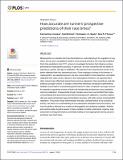Files in this item
How accurate are runners’ prospective predictions of their race times?
Item metadata
| dc.contributor.author | Liverakos, Konstantinos | |
| dc.contributor.author | McIntosh, Kate | |
| dc.contributor.author | Moulin, Christopher | |
| dc.contributor.author | O'Connor, Akira R. | |
| dc.date.accessioned | 2018-08-02T10:30:05Z | |
| dc.date.available | 2018-08-02T10:30:05Z | |
| dc.date.issued | 2018-08-01 | |
| dc.identifier | 254733541 | |
| dc.identifier | b66c4a27-4781-4748-8ad6-99c0f958fabd | |
| dc.identifier | 85050953545 | |
| dc.identifier | 000440415500048 | |
| dc.identifier.citation | Liverakos , K , McIntosh , K , Moulin , C & O'Connor , A R 2018 , ' How accurate are runners’ prospective predictions of their race times? ' , PLoS One , vol. 13 , no. 8 , e0200744 . https://doi.org/10.1371/journal.pone.0200744 | en |
| dc.identifier.issn | 1932-6203 | |
| dc.identifier.other | ORCID: /0000-0002-7943-5183/work/47136382 | |
| dc.identifier.uri | https://hdl.handle.net/10023/15752 | |
| dc.description | Three authors of the study have received financial support during the preparation of this manuscript. Kate McIntosh received summer internship funding from the University of St Andrews (funded internally by the University of St Andrews where Kate was an undergraduate student) to conduct analyses and visualise the data. Konstantinos Liverakos is in receipt of a PhD studentship from the AD Links Trust (funding external to the University of St Andrews where Konstantinos is a PhD student) and has conducted analyses, visualised data, and helped to prepared the manuscript during the period of his PhD. Christopher J.A. Moulin is a senior member of the Institut Universitaire de France. | en |
| dc.description.abstract | Metacognition is a domain which has illuminated our understanding of the regulation of cognition, but has yet to be applied in detail to more physical activities. We used half marathon finish time predictions from 7211 runners to investigate the factors that influence running performance metacognitive accuracy. In particular, we were concerned with the effects of experience, gender, and age on calibration. We expected more experienced runners to be better calibrated than less experienced ones. Given analogous findings in the domain of metacognition, we expected women to be less overconfident in their predictions, and better calibrated than male runners. Based on the metacognition literature, we expected that if older runners have effectively learned from previous experience, they would be as well-calibrated as younger runners. In contrast, uninformed inferences not based on performance feedback would lead to overestimating performance for older compared to younger runners. As expected, experience in terms of both club membership and previous race completion improved calibration. Unexpectedly though, females were more overconfident than males, overestimating their performance and demonstrating poorer calibration. A positive relationship was observed between age and prediction accuracy, with older runners showing better calibration. The present study demonstrates that data, collected before a test of physical activity, can inform our understanding of how participants anticipate their performance, and how this ability is affected by a number of demographic and situational variables. Athletes and coaches alike should be aware of these variables to better understand, organise, plan, and predict running performance, potentially leading to more appropriate training sessions and faster race finish times. | |
| dc.format.extent | 24 | |
| dc.format.extent | 3962611 | |
| dc.language.iso | eng | |
| dc.relation.ispartof | PLoS One | en |
| dc.subject | BF Psychology | en |
| dc.subject | 3rd-DAS | en |
| dc.subject.lcc | BF | en |
| dc.title | How accurate are runners’ prospective predictions of their race times? | en |
| dc.type | Journal article | en |
| dc.contributor.institution | University of St Andrews. School of Psychology and Neuroscience | en |
| dc.identifier.doi | https://doi.org/10.1371/journal.pone.0200744 | |
| dc.description.status | Peer reviewed | en |
This item appears in the following Collection(s)
Items in the St Andrews Research Repository are protected by copyright, with all rights reserved, unless otherwise indicated.

